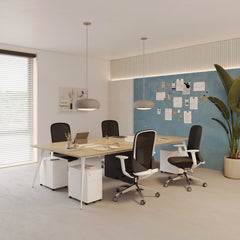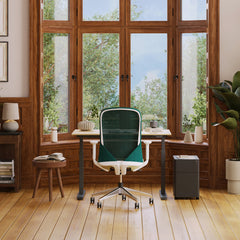Get 10% off your first order
Find the office furniture that’s designed to match your style, comfort, and needs perfectly. Subscribe
The Silent Energy Drain: Designing Tables and Chairs That Fight Work Fatigue

Visit quiz page to see how we makes it easy to create an inspiring workplace


In today's competitive market, a company's brand goes beyond its logo and marketing activities. It breathes and permeates every touchpoint, including the workplace. The role of office furniture in expressing your business story is often overlooked. Disjointed, uninspired furniture tells one message; well-curated, coherent design tells another.
A united office visual language is achieved through cohesive furniture design. It involves choosing elements that convey your company's values, culture, and goals. Harmony in style, materials, and utility enhances your organization's identity beyond matching colors. This strategic approach to furnishing strengthens your corporate identity, attracts top talent, and leaves a lasting impression on clients and employees. Your workspace represents your brand.
Every detail in your office sends a message, whether intentional or not. A client walking into a reception area furnished with mismatched chairs and a flimsy table will form a different impression than one entering a space with sleek, coordinated, and comfortable pieces. This initial perception, often subconscious, profoundly impacts how your brand is perceived. Cohesive design actively manages this perception, ensuring that every visual cue aligns with the brand image you wish to project.
The moment a client or visitor steps into your office, they begin to form an opinion about your company. This impression is heavily influenced by the aesthetic appeal and functionality of your furniture. Cohesive design ensures this critical first encounter reinforces your brand's professionalism and values.
The waiting area and meeting rooms are high-impact zones for client perception.
Professionalism: Coordinated, high-quality furniture instantly signals professionalism and attention to detail, implying similar qualities in your business operations.
Trust: A well-designed, comfortable space builds trust. It suggests stability and success, making clients more confident in your services.
Brand Storytelling: Does your furniture speak of innovation, tradition, creativity, or efficiency? Cohesive design makes that message clear from the outset.
Comfortable and visually appealing guest seating, integrated seamlessly with professional office desks in meeting rooms, communicates respect for clients' time and comfort. This subtle yet powerful gesture contributes positively to the overall client experience and strengthens their perception of your brand.
Your office environment profoundly impacts employee morale, productivity, and connection to the company's mission. Cohesive furniture design helps to cultivate a strong company culture by creating a consistent, inspiring, and functional space that reflects shared values.
When the furniture style, color palette, and quality are consistent throughout the office, it creates a unified identity. This helps employees feel part of something larger and more defined.
Shared Values: A modern, minimalist aesthetic suggests innovation and efficiency. A more classic, robust style might convey tradition and stability.
Belonging: A cohesive design makes the workplace feel like a deliberate, cared-for home for the brand, fostering a stronger sense of belonging among employees.
Pride: Employees take more pride in a workspace that is thoughtfully designed and visually appealing.
This consistent visual language reinforces brand identity not just externally, but also internally.
Every furniture choice, from materials to ergonomics, can be a direct reflection of your company's core values. Cohesive design consciously aligns these choices with what your brand stands for, whether it is sustainability, innovation, or employee well-being.
Your furniture can subtly or overtly communicate what matters most to your organization.
|
Value |
Design Choice |
Brand Message |
|
Sustainability |
Reclaimed wood, recycled materials, eco-friendly finishes. |
Responsible, future-focused, ethical. |
|
Innovation |
Sleek lines, cutting-edge technology integration, modularity. |
Forward-thinking, dynamic, adaptable. |
|
Employee Well-being |
Ergonomic chairs, sit-stand desks, comfortable break areas. |
People-first, supportive, health-conscious. |
For brands that prioritize employee health and productivity, ergonomic furniture is not just a benefit; it is a fundamental design principle. Integrating adjustable height desks throughout the office shows a tangible commitment to employee well-being, directly impacting their long-term health and daily performance. This choice speaks volumes about a company's values.
In today's competitive job market, the physical workspace is a key differentiator. A cohesively designed office, one that is both aesthetically pleasing and highly functional, is a powerful tool for attracting and retaining top talent. Candidates are increasingly scrutinizing office environments as an indicator of company culture and investment in its people.
A well-designed office environment signals a progressive, employee-focused culture.
"Wow" Factor: A visually appealing office creates a memorable first impression for prospective hires.
Perceived Value: Top talent often sees a thoughtfully designed space as an indicator that the company invests in its resources, including its human capital.
Comfort and Productivity: Candidates recognize the value of a comfortable, efficient workspace in preventing burnout and promoting high performance.
This contributes to a stronger employer brand, distinguishing you from competitors who may overlook the strategic importance of their physical space.
Brand cohesion should extend from individual workstations to collaborative zones. A unified design ensures that every part of the office feels connected and purposeful, reinforcing the idea of a single, integrated team working towards common goals.
Maintaining a consistent design language across different types of workspaces fosters a sense of unity and prevents the office from feeling fragmented.
Individual Focus Areas: Desks should align with the overall aesthetic while providing necessary individual functionality.
Meeting Rooms: Tables and chairs should echo the design language of the rest of the office, creating a seamless transition.
Breakout Zones: Even casual seating should tie into the overarching design theme.
This thoughtful integration of design creates a smooth visual journey throughout the office.

A cohesive and well-designed office does more than just look good; it actively contributes to productivity. An environment free from visual clutter and aesthetic discord reduces cognitive load, allowing employees to focus more effectively on their tasks.
Visual inconsistency can be a subtle form of distraction. When furniture styles clash, or colors are jarring, the brain expends energy trying to reconcile these discrepancies. A harmonious design minimizes this subconscious processing.
A harmonious visual environment can reduce mental fatigue and improve concentration. This positive correlation between workspace quality and employee output is a significant finding for any business. For organizations looking for concrete evidence to support design investments, reviewing a relevant work environment psychology study can offer deeper insights into how the physical space directly impacts employee performance and psychological well-being. This research underscores that cohesive design is not just about aesthetics but about creating a more effective working mind.
True cohesive design anticipates future needs. Your brand will grow and evolve, and your office furniture should be able to adapt without sacrificing its unified aesthetic. Modular and scalable design ensures that your brand consistency is maintained even as your physical space changes.
Modular furniture allows for easy rearrangement and expansion without needing to replace entire sets.
Easy Expansion: Add more desks or seating units that perfectly match existing ones.
Flexible Layouts: Reconfigure spaces quickly for new team structures or projects.
Cost-Effective: Invest in pieces that can grow with you, reducing the need for complete overhauls.
This forward-thinking approach ensures that your office branding remains consistent, even amidst dynamic growth.
Cohesive furniture design often implies a commitment to quality and durability. Investing in well-made pieces that stand the test of time sends a clear message about your brand's commitment to excellence and sustainability.
Flimsy or poorly constructed furniture can quickly deteriorate, sending a message of impermanence or corner-cutting. High-quality furniture, even if modern in design, conveys stability and reliability.
☐ Materials: Are they robust and suited for commercial use? (e.g., solid wood, commercial-grade steel, durable fabrics).
☐ Workmanship: Are joints strong, finishes consistent, and mechanisms smooth?
☐ Warranty: Does the manufacturer offer a strong warranty, indicating confidence in their product?
☐ Maintainability: Is the furniture easy to clean and maintain, ensuring it looks good for years?
Investing in durable, high-quality furniture is a long-term brand statement. It shows clients and employees that you value enduring quality in all aspects of your business.
Many businesses mistakenly view cohesive furniture design as an expensive luxury. However, when approached strategically, it is an investment that yields significant returns in brand perception, employee morale, and talent acquisition. Smart budgeting focuses on impact, not just initial cost.
Prioritize key areas for cohesive design impact:
Client-Facing Zones: Reception, meeting rooms.
High-Traffic Employee Areas: Break rooms, collaborative hubs.
Brand Storytelling Elements: Executive offices, showcase areas.
For companies with specific space needs or regional considerations, finding specialized solutions can be a key part of strategic budgeting. Whether you are outfitting a large corporate campus or a small, specialized branch office, pinpointing appropriate furniture that maintains brand consistency while meeting local demands is essential. An example of this tailored approach might involve sourcing a compact and reliable Small Standing Desk Missouri for a lean team, ensuring ergonomic benefits and brand aesthetic are not compromised by spatial constraints. This demonstrates a brand's commitment to quality at every scale.
Ultimately, cohesive furniture design transforms your office from a functional space into an experiential extension of your brand. It creates an immersive environment that consistently reinforces your identity, values, and professionalism.
Consistency: Every piece contributes to a unified aesthetic and functional experience.
Sensory Alignment: Beyond just visual, consider how materials feel and sounds are managed to align with your brand's character.
Memory Creation: A distinctive, well-designed office leaves a strong, positive memory for anyone who visits or works there.
Your office, through its cohesive design, becomes a powerful, silent ambassador for your brand. It speaks volumes about your commitment to excellence, your values, and your vision. It is a legacy crafted in every chair, every table, and every thoughtfully placed element.

Imagine your office as a stage where your brand performs daily. With cohesive furniture design, every prop, every backdrop, and every piece of scenery is meticulously chosen to tell a consistent, compelling story. It is the visual glue that holds your brand identity together, not just in brochures, but in the real, tangible space of your business.
This unified vision fosters pride, attracts partners, and inspires innovation. It transforms furniture from a mere collection of items into a strategic asset that broadcasts your brand's unique character. By investing in cohesive design, you are not just furnishing a space; you are crafting an experience, building a culture, and strengthening the very essence of your brand. Let your office furniture speak volumes about who you are.

The Silent Energy Drain: Designing Tables and Chairs That Fight Work Fatigue

The Performance Equation: Unlocking Employee Potential with Ergonomic Design

The Blueprint for Brilliance: Designing Workspaces For Team Focus
Get 10% off your first order
Find the office furniture that’s designed to match your style, comfort, and needs perfectly. Subscribe
Leave a comment